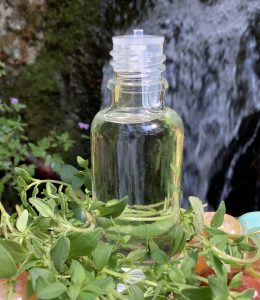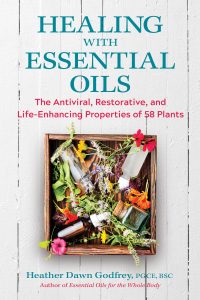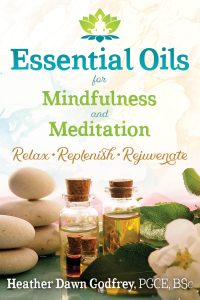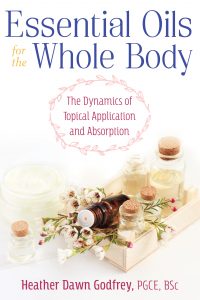- info@aromantique.co.uk
- 07419 777 451

Heather Dawn: Godfrey. P.G.C.E., B.Sc. (Joint Hon)
This article explores ways in which to support your immune system, and describes how essential oils can play a significant role.
For in-depth detail about the properties and qualities of essential oils and how to apply them safely and effectively, please refer to my books, Healing with Essential Oils, Essential Oils for the Whole Body and Essential Oils for Mindfulness and Meditation.
The article below includes excerpts from my new book, Healing with Essential Oils (working title), which is due to be published by Healing Arts Press, Inner Traditions, winter/spring 2022.
We have an intrinsic symbiotic and mutualistic relationship with plants. At the very least we depend on them to maintain the correct atmospheric gaseous balance between oxygen and carbon dioxide. They provide vital nutrients, including minerals, medicines, and energy from the biosynthesis of carbohydrates; they nourish, heal and vitalise. Fibrous plants provide materials for crafting clothes, tools and implements. And so on.
Not all plants contain essential oils, and not all essential oil containing plants are safe to consume.
Essential oils occur in plants as secondary metabolites. They are not vital to the plants existence, yet they play a significant supporting role. For example, essential oils exude volatile chemicals as a vaporous haze around the plant to ward off and protect the plant from predators and harmful microbes, and attract pollinators such as bees, butterflies, birds, and animals. This haze also reduces water loss, and relays signals to other similar plants. Within the plant essential oils behave like hormones, relaying messages in response to changes in atmospheric conditions, tissue injury, damage or disease, and invasive microbes, among other things. Essential also possess anti-microbial properties that help stave off infection and disease, and also have tissue-regenerating properties.
Just as within the plant, essential oils are not vital to our existence, yet gift us similar protective, restorative and regenerative properties.
Like a lock for a key, olfactory receptors detect volatile scent molecules and relay neural signals to the brain. Receptors are found not only in the nasal cavities, but also in other tissues and organs throughout the body, including the skin. Neural signals reach the Limbic System (the instinctive and emotional centre of the brain), which is connected, via the hypothalamus, to the pituitary gland (the master endocrine gland) and the frontal lobe of the brain (where we rationalise and make sense of information). Essential oils, thus, influence mood and emotion, aid memory, concentration, invoke mental alertness, stimulate hormone release, and more. Their molecules also rejuvenate and heal soft tissue. They aid metabolic function. They are adaptogenic (that is, they tend to target their actions according to need). They are restorative and protective. They support the immune system.
The human microbiome, just like a plants microbiome, consists of trillions of microbes, including viruses, bacteria and fungi, which symbiotically live in and on the body – on the skin, in the gut, and in cavities such as the mouth, ears and vagina – and within an auric-like cloud surrounding the body. The micro biome plays a significant role in protecting and maintaining immunity, and aids a number of vital bodily functions: for example, assisting the breakdown and synthesis of nutrients in the gut and aiding their appropriate absorption, and providing a protective barrier against invasion or proliferation of harmful microbes and pathogens, and more. We coexist with microorganisms; our body houses, feeds, and depends on their presence to maintain functional equilibrium. Poor diet, sugary refined foods, overuse of antibiotics and pharmaceutical drugs, stress and illness, among other factors, can disrupt the harmonious balance of the micro biome, and thus, increase our susceptibility to pathogenic invasion, disease and dysfunction.
Our first line of defence, when considering immunity, is to support our micro biome’s equilibrium (and thus also our health and vitality through optimum absorption, nourishment and resistance): for example, eating nutritionally rich, fresh, seasonal, unrefined, organic whole foods, especially green vegetables, fruits, nuts, beans and other legumes, fermented foods, and so on; drinking plenty of water to hydrate and oxygenate our cells, and flush out waste material from our system; also, fresh air, sunlight (photochemical formation of vitamin D), walking (movement and motion) and gentle exercise (to stimulate peristalsis in the gut, and stimulate the lymphatic system, to remove waste products efficiently from our body). A plants micro biome can also feed ours, hence the advisability of leaving the skin on organic vegetables and fruits, and eating these raw or just lightly cooked.
Our body, according to Tisserand (2020), is biologically programmed to react to essential oil constituents. Essential oil molecules interact with a variety of receptor sites, neurochemicals and enzymes, thus affording potential for therapeutic activity. In deed, the therapeutic action of essential oils is well evidenced, particularly in relation to pain management, wound healing, microbial staving, also anxiety, depression, agitation, insomnia, alertness and cognitive function.
The boundaries between physical, psychological and emotional (body, mind, and spirit) often overlap, as essential oils are shown to influence these both independently and together. Indeed, feeling happy, relaxed and calm, positive and optimistic demonstrably influences physical function; heart rate, blood pressure, cortisol levels, endorphin release, digestion, and so on. Therefore, our second line of defence, in terms of immunological support and healthy function, is our state of ‘being’ – ‘being in stress’ or ‘being in equanimity’, ‘being in fear’ or ‘being in peace’. Indeed, we are often reminded that unconditional ‘love’ is an optimum state of ‘being’. Our state of ‘being’ influences our state of ‘body’.
Hygiene, of course, is another line of defence. That is cleanliness, soap and water, rather than obsessive sterilisation. Observation of our microbiome, as already established, demonstrates that microbial co-existence is the background reality; far from being harmful, we actually thrive in their presence (as explained above) – our microbiome plays a significant role in fighting invading pathogens. There are times, though, when our natural defence mechanisms are compromised, perhaps through illness, stress, shock, anxiety, poor diet, lack of sufficient sleep, among other reasons, and this is when essential oils may ‘come into their own’ as supporting agents.
 What are essential oils?
What are essential oils?
Essential oils comprise of a concentrated mixture of up to two-hundred-and-fifty or so organic terpene (hydrocarbon) and terpinoid compounds (terpinoids are oxygenated hydrocarbons). Oxygenated compounds are grouped with other similar compounds according to their chemical structures and oxidising behaviours and classified collectively as a functional group: for example, alcohols, phenols, aldehydes, ketones, oxides, esters and ethers. Taken as a whole, though, all compounds in an essential oil contribute to its synergistic quality and therapeutic value. Knowing which functional group(s) predominates, however, provides a useful initial guide when determining potential therapeutic actions, scent profiles, hazards and contra-indications.
For example, lemongrass essential oil comprises of a large proportion of aldehydes (71%) – geranial (41%) and neral (30%) – and a small amount of limonene (0.28%), a monoterpene, among other compounds. Aldehydes are anti-infectious, anti-inflammatory, anti-fungal, and calming to the nervous system. Yet they are very reactive and readily oxidise to form organic acids: rendering them skin irritants and sensitisers, especially if they are not stored appropriately. In terms of scent profile, geranial has a light sharp, fresh odour, characteristic of lemon. Neral has a light, sharp odour, somewhat less fresh than geranial. Limonene has a lemony sometimes turpentine-like odour. As a whole, including the remaining smaller compounds not identified previously, the odour of lemongrass is described as being fresh, citrus, slightly oily; with strong, lemony, herbal, green, tea-like body notes; and herbaceous somewhat oily dry-out notes (Williams 2006).
The Antimicrobial Qualities of Essential Oils
Essential oils are (with varying degrees of strength depending on the presence and combination of chemicals in their mix) generally anti-viral, anti-bacterial, anti-fungal, anti-inflammatory, and mucolyptic. They can be applied to prevent and stave the spread of infection, and ease symptoms, such as pain, digestive upset and headaches, cold and ‘flu-like’ symptoms, and to treat skin conditions. Even when applied in very small amounts, essential oils may ease psycho-emotional conditions (low mood, anxiety, brain fog, etc.), minor infections (coughs, colds, insect bites) and skin conditions (cuts, grazes, eczema, dry skin, etc.). It is advisable to seek medical advice before self-treating acute, potentially infectious conditions, such as influenza, or other viral conditions, or conditions of which you are unsure of.
A large quantity of essential oil is required to fumigate an environment (at least 30 drops depending on the size of the space); this is best done when no one is in the room to avoid irritation (eyes, nose, throat and lungs). To fumigate safely and efficiently, close all doors and windows to contain the essential oil infused vapours, and diffuse for 30 minutes. Leave the room during fumigation. Once fumigation is complete, open windows and doors to allow an inflow of fresh air to clear residual vapours.
Dried herbs, such as sage, rosemary, and juniper can be used instead of essential oils – these are usually ‘smoked or smudged’, that is, smouldered, to cleanse the atmosphere of pathogens.
Essential Oils that are strongly anti-microbial
Please note that some of the essential oils listed below are strong irritants and sensitisers Always check the qualities and contra indications of an essential oil before applying it, and do not diffuse essential oils near the head-space of infants (who are more easily prone to respiratory irritation).
Apply 2-3 drops on a tissue and inhaled, 2-4 drops in steam inhalation, 2-4 drops in 10ml of carrier medium (vegetable oil, non-perfumed, lotion, cream, or aqueous gel) for skin application – do not use these oils or blends of these oils neat on skin or in the bath.
Cinnamon bark
Clove bud/leaf
Eucalyptus blue gum / radiate / globulus
Tea tree
Thyme red
Geranium bourbon/rose
Lavender
Lemon
Scotch Pine
These are but a few popular examples. For more essential oils and further information about the antimicrobial properties of essential oils, please refer to my book, Healing with Essential Oils (Inner Traditions, Bear and Co.)
Guidelines for safe use
If essential oils are used frequently, for whatever reason (in beauty products, as perfumes, for minor conditions, for relaxation, and so on), then regularly change the oil or blend of essential oils you use (there are numerous essential oils with similar qualities, so alternatives are available) and have a break from use every so often. This will reduce the risk of sensitisation.
Add up to 15 to 20 drops of essential oil to a hand sanitizer (non-perfumed liquid soap dispenser). Do not add essential oils to an antibacterial sanitizer or pre-scented sanitizer (it is not necessary, and avoids risk of irritation). Soap, itself, is antibacterial – soap and water (careful hand washing and drying) are usually sufficiently effective.
Do not diffuse irritating essential oils in public spaces or too close to other people. Always dilute essential oils in an emollient (for example, vegetable oil, cream or lotion) when applying them to skin.
Regularly change the essential oil, or the combination of essential oils, applied in a blend, to avoid sensitisation (as previously mentioned). Do not take these or any essential oils internally (unless under specific professional medical or healthcare supervision). Babies, children, people who are asthmatic or have other pre-existing respiratory conditions, or very elderly or frail, are especially vulnerable in terms of sensitisation and potential irritancy of their airways when exposed to essential oil vapours.
Essential oils and sustainability
Purchase essential oils from suppliers who obtain their oils from sustainable sources.
Due to increased popularity, the market potential of essential oils has increased exponentially in recent years. This increases propensity for product abuse. A pure essential oil is the unadulterated product of extraction, nothing more, nothing less. A good supplier will provide certified evidence of an essential oils origin and chemical composition, and will verify that their oils are derived from a sustainable source.
Summary
Applied appropriately, essential oils are ‘scentually’ very pleasant, safe and incredibly versatile with regard to their therapeutic actions (for example, anti-microbial, skin care and tissue regeneration, psycho-emotional, and more). They are valued for their preventative and supportive properties (for example, anti-inflammatory and tissue regeneration), and may be useful during the early stages of an infection. However, although some essential oils posses a broad spectrum of anti-microbial and antibiotic-like qualities and actions, others are more specific and/or have weaker strength and potency. A clear understanding of an essential oils individual anti-microbial components and the nature of pathogens and how these infiltrate the body, is required to target essential oils effectively and safely. If symptoms are persistent, unexplained, or you feel generally unwell, you are advised to seek medical advice from a certified healthcare professional.
References
Author bio
Heather was introduced to essential oils, alongside other integrated therapy principles and practices, in the early 70’s. She later studied at the University of Salford, gaining a BSc (Joint Hon) Degree in Counselling and Complementary Medicine, and post-graduate Masters Certificates in Integrated Mindfulness, and Supervision of Counsellors, and a Post Graduate Teaching Certificate (PGCE) (Bolton Institute).
Heather taught for several years at the University of Salford in the School of Health Sciences and Social Care.
Relocating from Lancashire to Dorset a few years ago, Heather continues to run a private aromatherapy clinic, and teaches essential oil related courses and workshops.
Healing with Essential Oils (published by Healing Arts Press, Inner Traditions Bear & Com, Vermont USA)

Essential Oils for Mindfulness and Meditation (published by Healing Arts Press, Inner Traditions, Bear & Co., Vermont USA)

Essential Oils for the Whole Body (published by Healing Arts Press, Inner Traditions, Bear & Co., Vermont USA)
